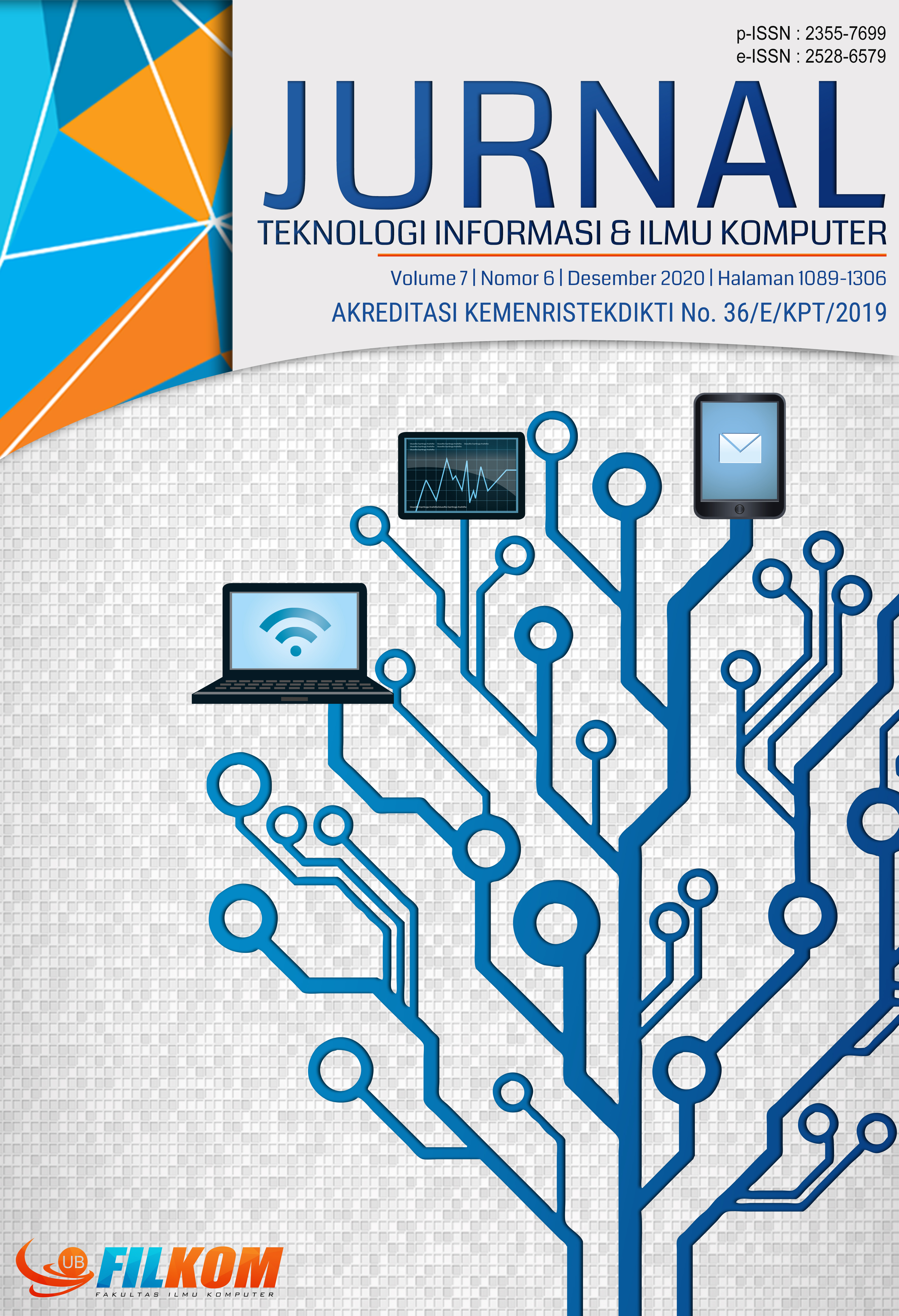Sentralisasi Pengawasan Informasi Jaringan Menggunakan Blockchain Ethereum
DOI:
https://doi.org/10.25126/jtiik.2020722662Abstrak
Pengawasan jaringan pada beberapa kantor yang berlokasi berjauhan sangat sulit dilakukan kerana keterbatasan tenaga ahli, biaya, dan teknologi pendukung. Penelitian yang sudah ada tidak dapat menyediakan sistem pengawasan jaringan yang mampu menjamin tiga aspek keamanan sekaligus, yaitu: availability, integrity, dan confidentiality. Teknologi blockchain mampu menyediakan sistem pengawasan jaringan secara terpusat dan aman dengan menjamin keamanan sistem komunikasi pelaporan dan sistem basis data pelaporan. Penelitian ini bertujuan untuk menyajikan purwarupa sistem pengawasan konfigurasi dan statistik jaringan menggunakan jejaring blockchain Ethereum. Metode pengawasan mengharuskan program controller pada setiap jaringan kantor untuk secara berkala menarik informasi flow-rules dari setiap perangkat jaringan dan melaporkan data tersebut dalam sebuah transaksi ke jejaring blockchain. Pada penelitian ini dianalisa dua jenis skema pengiriman transaksi: transaksi berbasis smart contract dan transaksi berbasis zero-payment. Berdasarkan hasil pengujian, transaksi berbasis zero-payment secara rerata hanya membutuhkan sekitar 6 % dari biaya transaksi smart contract. Perkiraan biaya bulanan untuk pensamplingan informasi setiap 10 menit adalah sekitar 1,19 ether per-perangkat jaringan. Meskipun demikian, metode pada penelitian ini lebih sesuai untuk diterapkan pada jejaring Ethereum jenis Proof-of-Authority (PoA) dibandingkan jenis Proof-of-Work (PoW) karena harga Ether yang mahal.
Abstract
Centralized monitoring of remote networks is hard to implement due to the high cost, lack of experts, and the missing key technologies. The existing researches are unable to provide a secure, centralized monitoring system that satisfies three security aspects, namely: availability, integrity, and confidentiality. Blockchain technology meets those three requirements by providing a reliable reporting and immutable database system. In this paper, we proposed a prototype of a centralized monitoring system that records network statistics and configurations into the blockchain ledger. The method requires the network controller to periodically fetch network information from every network device and submit it as a single blockchain transaction. We compare two kinds of transaction schema, smart-contract based and zero-payment based reporting schemes. The evaluations show that zero-payment transactions only cost 6 % of the smart-contract transactions. The estimation of the monthly cost is 1.19 ether per-device for 10-minutes data sampling. Nevertheless, the proposed method is applicable only for the Proof-of-Authority (PoA) Ethereum networks. It is not feasible for the Ethereum main network that uses Proof-of-Work (PoW) due to the high cost of Ether.
Downloads
Referensi
BUTERIN, V. 2014. A next-generation smart contract and decentralized application platform. white paper, 3, 37.
Ethers.js. 2016. What is ethers.js. [online] Tersedia di <https://github.com/ethers-io/ethers.js/> [Diakses 2 Oktober 2019]
FIESSLER, A., LORENZ, C., HAGER, S., & SCHEUERMANN, B., 2018. FireFlow-High Performance Hybrid SDN-Firewalls with
OpenFlow. In 2018 IEEE 43rd Conference on Local Computer Networks (LCN) (pp. 267-270). IEEE.
GERMANN, B., SCHMIDT, M., STOCKMAYER, A., & Menth, M. 2018. OFFWall: A Static OpenFlow-Based Firewall Bypass. In 11.
DFN-Forum Kommunikationstechnologien. Gesellschaft für Informatik eV.
KAUR, K., SINGH, J., & GHUMMAN, N. S. 2014. Mininet as software defined networking testing platform. In International Conference on Communication, Computing & Systems (ICCCS) (pp. 139-42).
MCKEOWN, N., ANDERSON, T., BALAKRISHNAN, H., PARULKAR, G., PETERSON, L., REXFORD, J., ... & TURNER, J. 2008. OpenFlow: enabling innovation in campus networks. ACM SIGCOMM Computer Communication Review, 38(2), 69-74.
PATIL, S., & SUBHEDAR, M. S. 2019. Optimizing MPLS Tunnel Creation Performance by Using SDN. In Soft Computing and Signal Processing (pp. 527-536). Springer, Singapore.
PFAFF, B., PETTIT, J., KOPONEN, T., JACKSON, E., ZHOU, A., RAJAHALME, J., ... & AMIDON, K. 2015. The design and implementation of open vswitch. In 12th {USENIX} Symposium on Networked Systems Design and Implementation ({NSDI} 15) (pp. 117-130).
PHATAK, A., KADIKAR, R., VIJAYAN, K., & AMUTHA, B. ,2018. Performance Analysis of Firewall Based on SDN and OpenFlow. In 2018 International Conference on Communication and Signal Processing (ICCSP) (pp. 0611-0615). IEEE.
POA. 2014, Welcome to POA. [online] Tersedia di <https://www.poa.network/ PoA> [Diakses 2 Oktober 2019]
Ryu SDN Framework. 2011. [online] Tersedia di <https://osrg.github.io/ryu/> [Diakses 1 Oktober 2019]
SUBRATIE, K., & FIGUEIREDO, R. (2018, October). Towards Island Networks: SDN-Enabled Virtual Private Networks with Peer-to-Peer Overlay Links for Edge Computing. In International Conference on Internet and Distributed Computing Systems (pp. 122-133). Springer, Cham.
VAN DER POL, R., GIJSEN, B., ZURANIEWSKI, P., ROMÃO, D. F. C., & KAAT, M. 2016. Assessment of SDN technology for an easy-to-use VPN service. Future Generation Computer Systems, 56, 295-302.
Unduhan
Diterbitkan
Terbitan
Bagian
Lisensi

Artikel ini berlisensi Creative Common Attribution-ShareAlike 4.0 International (CC BY-SA 4.0)
Penulis yang menerbitkan di jurnal ini menyetujui ketentuan berikut:
- Penulis menyimpan hak cipta dan memberikan jurnal hak penerbitan pertama naskah secara simultan dengan lisensi di bawah Creative Common Attribution-ShareAlike 4.0 International (CC BY-SA 4.0) yang mengizinkan orang lain untuk berbagi pekerjaan dengan sebuah pernyataan kepenulisan pekerjaan dan penerbitan awal di jurnal ini.
- Penulis bisa memasukkan ke dalam penyusunan kontraktual tambahan terpisah untuk distribusi non ekslusif versi kaya terbitan jurnal (contoh: mempostingnya ke repositori institusional atau menerbitkannya dalam sebuah buku), dengan pengakuan penerbitan awalnya di jurnal ini.
- Penulis diizinkan dan didorong untuk mem-posting karya mereka online (contoh: di repositori institusional atau di website mereka) sebelum dan selama proses penyerahan, karena dapat mengarahkan ke pertukaran produktif, seperti halnya sitiran yang lebih awal dan lebih hebat dari karya yang diterbitkan. (Lihat Efek Akses Terbuka).












